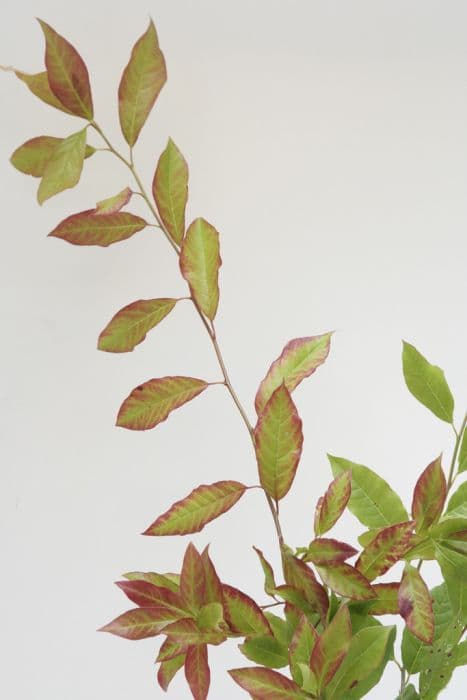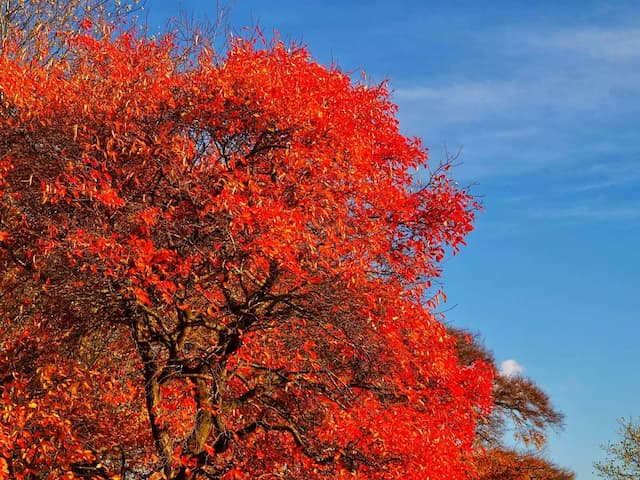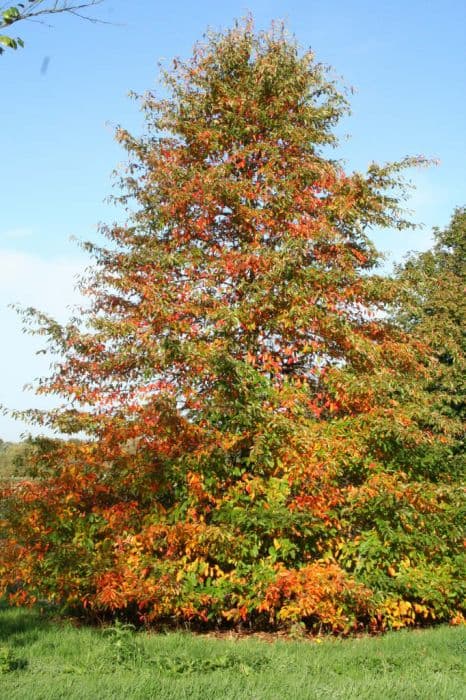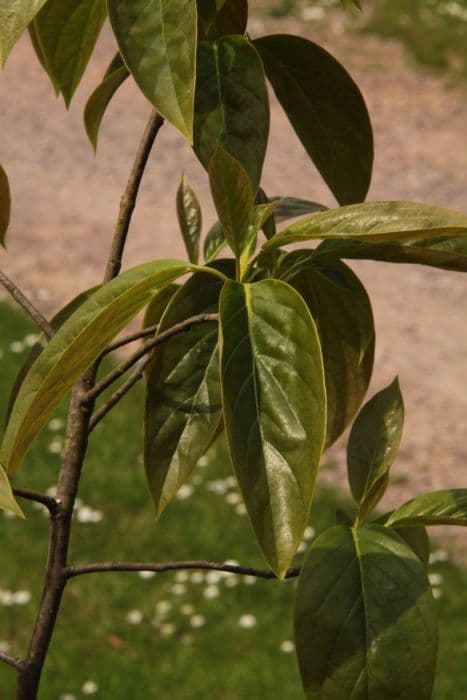Dove tree Davidia involucrata var. vilmoriniana











ABOUT
The plant commonly known as the dove tree is renowned for its unique and beautiful appearance. This deciduous tree is best identified by its striking floral display. The true flowers are small and clustered together, but what really catches the eye are the two large, pure white, modified leaves, or bracts, that surround each flower cluster. These bracts, which can be misconstrued as petals, resemble handkerchiefs or doves perched on the branches, giving the plant its evocative common names, handkerchief tree and dove tree respectively. The dove tree blooms in spring, with the bracts initially appearing greenish-white before turning a brilliant white as they mature. This fantastic floral show provides a dramatic contrast against the tree's lush green foliage. The leaves of the dove tree are broadly ovate with pointed tips and serrated edges giving them a soft, somewhat serrated texture. In autumn, the leaves turn a spectacular shade of yellow, making this tree a focal point in any landscape throughout multiple seasons. Adding to its visual interest, the dove tree also produces round, greenish-brown fruit, which hang from the branches, providing yet another layer of texture to the tree's overall aesthetic. The distinct appearance of the dove tree, with its seasonal changes and remarkable bracts, make it a prized specimen in gardens that can accommodate its specific growing requirements.
About this plant
 Names
NamesFamily
Nyssaceae.
Synonyms
Dove Tree, Handkerchief Tree, Ghost Tree, Pocket Handkerchief Tree, Laundy Tree.
Common names
Davidia involucrata, Davidia involucrata var. dobbinsii, Davidia laeta, Davidia vilmoriniana.
 Toxicity
ToxicityTo humans
The plant commonly known as the Dove Tree (Davidia involucrata var. vilmoriniana) is not known to be toxic to humans. There are no well-documented cases of poisoning from this plant, and it is generally considered safe. However, as with any plant, individual allergies or sensitivities could potentially occur, but this is not common.
To pets
Similar to its effects on humans, the Dove Tree (Davidia involucrata var. vilmoriniana) is not known to be toxic to pets. There is no established record of toxicity in domestic animals such as cats and dogs, and the plant is regarded as non-poisonous. As always, it is best practice to prevent pets from eating plants as a precaution, and to consult with a veterinarian if any unusual behavior or symptoms arise after ingestion.
 Characteristics
CharacteristicsLife cycle
Perennials
Foliage type
Deciduous
Color of leaves
Green
Flower color
White
Height
20-40 feet (6-12 meters)
Spread
15-30 feet (4.5-9 meters)
Plant type
Tree
Hardiness zones
6-8
Native area
China
Benefits
 General Benefits
General Benefits- Ornamental Value: Davidia involucrata var. vilmoriniana, commonly known as the Dove Tree, is highly regarded for its unique and showy white bracts that resemble doves or handkerchiefs, making it a stunning focal point in any garden.
- Shade Provision: The Dove Tree is a medium to large deciduous tree that provides ample shade once mature, making it ideal for residential gardens or parks.
- Wildlife Attraction: The tree produces flowers that can attract pollinators like bees and butterflies, enhancing local biodiversity.
- Seasonal Interest: With vivid autumn colors, the Dove Tree offers seasonal interest throughout the year.
- Cultural Significance: The Dove Tree has cultural importance in certain regions, often planted for its symbolic beauty and the serene visual effect it creates.
- Educational Interest: As a unique species with distinctive features, the Dove Tree is often used in educational settings to teach botany and plant identification.
- Landscape Design Versatility: It can be used in a variety of landscape designs, from formal to woodland gardens, because of its versatility and adaptability to different settings.
 Medical Properties
Medical PropertiesThis plant is not used for medical purposes.
 Air-purifying Qualities
Air-purifying QualitiesThis plant is not specifically known for air purifying qualities.
 Other Uses
Other Uses- The handkerchief tree can be used as an educational tool in botany and horticulture classes, serving as a live example to study the unique evolutionary adaptations of flowering plants.
- Dried bracts of the handkerchief tree can be used in floral arrangements and crafts, offering an intriguing and uncommon texture to the compositions.
- The tree's large leaves can be used in various artistic practices, such as leaf painting or eco-printing, to create natural patterns and designs on fabric or paper.
- Because of its distinctive appearance when blossoming, the handkerchief tree is an excellent choice for themed gardens, such as those focusing on rare or unique plants.
- The strong wood of the handkerchief tree is sometimes used to make small wooden objects like handles, ornaments, or in marquetry.
- In landscaping, the handkerchief tree can be used as a focal point in garden design, drawing attention for its unique beauty and shape.
- Photographers and painters might use the handkerchief tree as a subject for their works due to its striking flowers and overall aesthetic appeal.
- Its pattern of blooming can be used by educators as a way to teach about phenology, the study of cyclic and seasonal natural phenomena.
- In large gardens or parks, the handkerchief tree serves as a shade tree, providing a cool area for relaxation during hot summer months.
- The handkerchief tree may also be planted as part of conservation efforts in botanical gardens or arboretums to preserve this unusual species.
Interesting Facts
 Feng Shui
Feng ShuiThe Dove Tree is not used in Feng Shui practice.
 Zodiac Sign Compitability
Zodiac Sign CompitabilityThe Dove Tree is not used in astrology practice.
 Plant Symbolism
Plant Symbolism- Peace: Often referred to as the Dove Tree, Davidia involucrata var. vilmoriniana is symbolic of peace and tranquility, much like the dove is seen as a symbol of peace.
- Spirituality: The unique appearance of the flowers, resembling a dove or handkerchiefs, invokes a spiritual feeling, often representing the ascension, purity, and the holy spirit.
- Rarity and Uniqueness: Known for its distinctiveness, this plant symbolizes rarity and the uniqueness of an individual due to the scarcity with which it blooms and its unusual flower shape.
- Beauty in Isolation: The Dove Tree is often found in the forest, standing alone with its beautiful flowers, symbolizing the idea that true beauty stands out even in isolation.
- Purity: The white color of the flowers' bracts is traditionally associated with purity and innocence, akin to the white of the dove.
 Water
WaterFor the Dove Tree, it's essential to maintain moist soil, especially during the growing season. Water the tree thoroughly once or twice a week, depending on weather conditions; more frequently during dry spells. Each watering session should use around 2 gallons of water to ensure deep soil saturation. It's important to reduce watering frequency in the winter when the tree is dormant, providing enough to prevent the soil from drying out completely.
 Light
LightDove Trees prefer a spot with full sun to partial shade. The best lighting condition is where the plant receives morning sunlight and is protected from the intense heat of the afternoon sun. An ideal location would offer dappled sunlight throughout the day, preventing leaves from scorching while ensuring adequate light for growth.
 Temperature
TemperatureThe ideal temperature range for a Dove Tree is between 60 to 75°F. It can withstand temperatures down to 20°F, but it is important to protect it from sudden frosts. The tree thrives in areas with mild summers and cool winters, avoiding extremes of heat or cold.
 Pruning
PruningPruning the Dove Tree should be done to remove dead or damaged branches and to shape the tree for a balanced structure. It's best to prune in late winter or early spring before new growth starts. Pruning should be done annually, but light maintenance pruning can be done as needed throughout the growing season.
 Cleaning
CleaningAs needed
 Soil
SoilThe best soil mix for the Dove Tree (Davidia involucrata var. vilmoriniana) should be rich, well-drained, and high in organic matter. A mixture of loam, peat, and sand or perlite can provide the desired structure and nutrients. The ideal soil pH for the Dove Tree is slightly acidic to neutral, ranging from 6.0 to 7.0.
 Repotting
RepottingThe Dove Tree (Davidia involucrata var. vilmoriniana) does not require frequent repotting as it's a slow-growing tree; repotting every 3 to 5 years should suffice. Younger, container-grown trees may need repotting more often to encourage growth.
 Humidity & Misting
Humidity & MistingThe Dove Tree (Davidia involucrata var. vilmoriniana) thrives in moderate humidity levels, typical of outdoor environments. It does not have specific high humidity requirements, so aiming for a natural, outdoor-like humidity level is beneficial.
 Suitable locations
Suitable locationsIndoor
Limited space makes indoor cultivation challenging for the Dove Tree.
Outdoor
Plant in moist, humus-rich soil; partial sun; shelter from strong winds.
Hardiness zone
6-8 USDA
 Life cycle
Life cycleDavidia involucrata var. vilmoriniana, commonly known as the dove tree, begins its life cycle as a seed that germinates in moist, well-drained soil in partial to full shade. After germination, the seedling gradually develops into a young sapling, with distinctive heart-shaped leaves, which continues to establish itself for several years before reaching maturity. As a mature tree, it produces unique white bract-like structures, often referred to as "dove-like" flowers, in the spring which are actually specialized leaves surrounding the smaller true flowers. Following the flowering stage, the plant produces a hard-shelled nut that contains the seeds, completing its reproductive process. The dove tree is a slow grower, often taking 10 years or more to flower for the first time, and can live for many decades, continuing to grow and reproduce annually. During its lifespan, it undergoes seasonal changes, dropping its leaves in the fall and entering a period of dormancy during the winter months.
 Propogation
PropogationPropogation time
Spring to early summer
The Davidia involucrata var. vilmoriniana, commonly known as the Dove Tree or Handkerchief Tree, is generally most successfully propagated through seed, which is the most popular method. The best time for sowing seeds is in the fall, directly after collection. Fresh seeds exhibit deep dormancy and require a period of cold stratification to mimic winter conditions and induce germination. Typically, this involves mixing the seeds with moist sand and storing them in a refrigerator at a temperature of about 40 degrees Fahrenheit (4 degrees Celsius) for 60-90 days. After stratification, the seeds are sown in a well-draining seed starting mix, lightly covered with soil, and left to germinate, which can take several months. Young seedlings need protection from frost and should be grown on in pots for at least a couple of years before being planted out in their final position in the garden.




